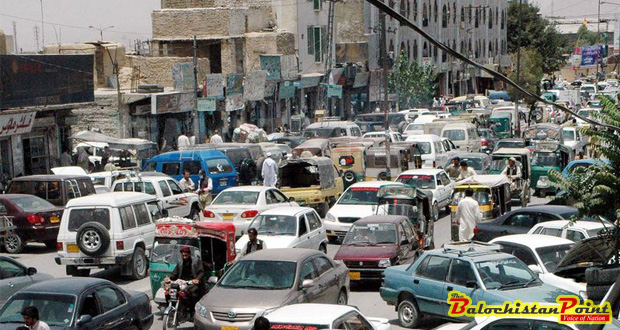By: Sabir Shahwani Baloch
Social, economic and technical advancements have yielded rapid urbanization in developing countries. This increase in urbanization is characterized by high population density, traffic congestion, poor drainage, inadequate infrastructures and other related spatial, technical and social issues. These issues are further augmented in the form of increased motorization. These ultimately end up with restriction in accessibility and smooth flow of traffic, formations of long vehicle queues and bottlenecks, increased travel time, reduced traffic level of service (LOS), polluted environment and physical and mental frustrations.
Quetta is Balochistan’s capital city and the largest city with over 1 million inhabitants. The city is a major economic hub and so has attracted the people from all over the province. This influx of people resulted growing population. To overcome the daily transportation needs, the people have to travel through different modes on daily basis as per their requirements and possession of vehicles and income. Therefore, the public transportation system in city is in bad shape and its performance needs lot to be desired. It is completely in dis-array and disorganized and thus not able to fulfill the intra-city transportation needs of residents. Poor public transport system encouraged the people to use private vehicles. Hence, the number of vehicles plying on the roads increased manifold and is still rising day by day. The situation further became worsened as the roads and other infrastructure were initially designed decades ago to cater the needs of the city traffic prevalent at that time.
According to Traffic Police Quetta, the city roads were planned and designed for a population of 50,000 people whereas the number of vehicles have surged in hundreds and now the scenario has totally been changed. At present, traffic demand on these roads is much higher than the capacity of these roads which cannot accommodate the current heavy traffic especially during peak times of the day. Major arterials, collectors and local roads (which are also in deteriorated condition) experience worst traffic jams during peak times of the day. Furthermore, there are several other traffic related problems such as parking, encroachments, bus terminals, animal driven carts, etc. that need to be discussed briefly.
Apart from these problems, situation has also aggravated due to poor traffic planning and management. A very little or no coordination exists among the concerned departments such as provincial transport department, QDA, C&W, SSGC and WASA etc. QDA and transport department being the main stakeholders responsible for provision of transport infrastructure facilities, lack expertise and traffic professionals. It is a very alarming and astounding situation that there is no transportation/traffic engineer within the provincial transport department. This indicates the level of government’s interest and support to develop and improve the transportation infrastructure system so as to resolve the transportation/traffic issues in city. Quetta Development Authority in its mission clearly indicates a number of transportation/traffic related issues, schemes and projects. Moreover, QDA has a major recommendation to establish a traffic engineering cell within it. But unfortunately, there is no transportation/traffic engineer to handle the traffic issues. Traffic Police is used to regulate and manage the traffic within the city, which is not a traffic regularity body rather an agency to enforce and implement traffic rules and regulations.
A mass transit project (Light Rail) of around 48 km has also been proposed for the city and the feasibility study report has been submitted by a Chinese company to the government. The allocation for the said project has also been made in last three budgets i.e. Budget 2016-17, 2017-18 and 2018-19 respectively. It has also been proposed to establish a mass transit authority to look after and carry out the operations of mass transit system on similar lines as being practiced by Punjab Mass Transit Authority. Hiring for the post of Project Manager was also advertised but later on it was cancelled and no further steps in this regard have been taken.
The solution of above mentioned problems warrants and necessitates that these should be raised and addressed properly at every forum/platform. Moreover, all these problems are of technical nature and can only be solved by procuring the services of qualified and trained experts in the field of traffic engineering, traffic planning and traffic management. At the institutional level, QDA should establish and operate its traffic engineering cell. Provincial transport department should hire transportation engineers at provincial as well as divisional level. Transportation engineers need to be appointed into mass transit projects as well as in proposed Balochistan Mass Transit Authority. Provincial C&W department although has civil engineers working in it, must also hire specialized transportation/traffic engineers to improve and strengthen its infrastructure and road safety which has gained importance all over the world. As long as traffic/transportation engineers are not inducted into these provincial departments, the traffic and transportation problems would neither be minimized nor can road safety be improved in the province.
Published in The Balochistan Point on October 12, 2018
 Balochistan Point Voice of Nation
Balochistan Point Voice of Nation




